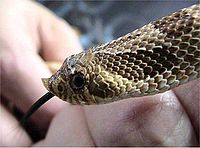- Heterodon nasicus
-
Heterodon nasicus 
Conservation status Scientific classification Kingdom: Animalia Phylum: Chordata Subphylum: Vertebrata Class: Reptilia Order: Squamata Suborder: Serpentes Family: Colubridae Subfamily: Xenodontinae Genus: Heterodon Species: H. nasicus Binomial name Heterodon nasicus
Baird & Girard, 1852"Bluffers" redirects here. For other uses, see Bluffers (disambiguation).Heterodon nasicus is a harmless colubrid species found in North America and northern Mexico. Three subspecies are currently recognized, including the typical form described here.[1]
Contents
Description
The Western Hognose Snake is a light sandy brown in color, with darker brown or gray blotching, their coloration is not nearly as variable as the Eastern Hognose, Heterodon platirhinos, but they often have an ink-black and white or yellow checker patterned belly, sometimes accented with orange. They are very stout for their size (a full grown 24-inch female is as bulky as a five-foot corn snake) and can grow from 15 to 33 inches in length, with females generally being larger than males. The characteristic of all hognose snakes is their upturned snout, which aids in digging in the soil. Hognose Snakes are considered to be rear-fanged venomous, but are not considered to pose any danger to humans and will only bite as a feeding response, rarely in defense. The defensive bite response is usually due to the temporary blindness experienced while shedding. Because the snake cannot see while shedding, it becomes skittish and more prone to bite in defense.
Common names
Blowing adder, blowing viper, blow snake, bluffer, common western hog-nosed viper, (western) hog-nosed snake, faux viper, North American long-nosed snake, prairie hog-nosed snake, puff(ing) adder, sand viper, spoonbill snake, spreadhead snake, spreading adder, spreading viper, Texas hog-nosed snake, Texas rooter, western spreading adder, western hog-nosed adder, western hog-nosed snake, [2] plains hognose snake.[1]
Geographic range
Found from southeastern Alberta and southwestern Manitoba in Canada, south to southeastern Arizona and Texas in the United States and into northern Mexico. Disjunct populations in Minnesota, Iowa, Illinois, Missouri, Montana, and Arkansas.[3]
Conservation status
This species is classified as Least Concern (LC) on the IUCN Red List of Threatened Species (v3.1, 2001).[4] Species are listed as such due to their wide distribution, presumed large population, or because it is unlikely to be declining fast enough to qualify for listing in a more threatened category. The population trend is stable. Year assessed: 2007.[5]
However, it is listed as endangered in the state of Iowa, and threatened in Illinois and South Dakota. It is more common in the southern end of its range, where holds no particular conservation status.
Behavior
The Western Hognose Snake is primarily diurnal, and makes use of a variety of habitats, including shortgrass prairies, grasslands, and rocky, semi-arid regions. It is typically a docile snake (though known to be highly aggressive in some individuals), that may hiss and make mock strikes if harassed, and even play dead if stressed enough. They feed on amphibians, lizards, and rodents. They breed in the spring, laying 4 to 23 eggs in the mid summer, which take approximately 60 days to hatch.
Reproduction
Oviparous, with females laying 4-23 elongate, thin-shelled eggs in June-August. Hatchlings are 15-19 cm in length and reach sexual maturity after two years.[3]
Captivity
This species is more commonly kept and bred in captivity than any other member of its genus. It is small and hardy with a docile nature. Commercially available rodents are readily consumed and not much space or specialized care is required. It is also bred commercially with many color variations available.
Subspecies
Subspecies[1] Authority[1] Common name[1] Geographic range[2] H. n. gloydi Edgren, 1952 Gloyd's hog-nosed snake United States: southeastern Kansas and southeastern Missouri, eastern Oklahoma and all of Texas excluding the panhandle, trans-pecos Texas and the extreme southern Rio Grande Valley. H. n. kennerlyi Kennicott, 1860 Kennerly's hog-nosed snake Mexico from Tamaulipas and central San Luis Potosí, north and west along the Cordillera Occidental, entering the United States in the extreme south of the Rio Grande Valley, trans-pecos Texas, southwestern New Mexico and southeastern Arizona. H. n. nasicus Baird & Girard, 1852 Western hog-nosed snake Texas panhandle and adjacent New Mexico, north through western Oklahoma and Kansas to southwestern Manitoba and southeastern Saskatchewan in Canada. Also occurs in prairie regions of Minnesota and prairie relicts of Illinois. Taxonomy
Some authors elevate H. n. kennerlyi, also known as the Mexican hog-nosed snake, to species level. Those same authors have subsumed H. n. gloydi into H. nasicus so that there are only 2 species (H. nasicus and H. kennerlyi) and no subspecies.
References
- ^ a b c d e f "Heterodon nasicus". Integrated Taxonomic Information System. http://www.itis.gov/servlet/SingleRpt/SingleRpt?search_topic=TSN&search_value=174155. Retrieved 28 November 2006.
- ^ a b Wright AH, Wright AA. 1957. Handbook of Snakes. Comstock Publishing Associates. (7th printing, 1985). 1105 pp. ISBN 0-8014-0463-0.
- ^ a b Behler JL, King FW. 1979. The Audubon Society Field Guide to North American Reptiles and Amphibians. New York: Alfred A. Knopf. 743 pp. LCCCN 79-2217. ISBN 0-394-50824-6.
- ^ Heterodon nasicus at the IUCN Red List. Accessed 14 September 2007.
- ^ 2001 Categories & Criteria (version 3.1) at the IUCN Red List. Accessed 14 September 2007.
External links
- Heterodon nasicus at the Reptarium.cz Reptile Database. Accessed 14 September 2007.
- Heterodon nasicus at Herps of Texas. Accessed 14 September 2007.
- Heterodon nasicus at Illinois Natural History Survey. Accessed 14 September 2007.
- Heterodon nasicus at Animal Diversity Web. Accessed 14 September 2007.
- Heterodon nasicus at Kansas Herpetofaunal Atlas: . Accessed 14 September 2007.
- General care guide for H. n. nasicus, at Animal Allsorts. Accessed 14 September 2007.
- Western Hognose Snake at Herpnet.net. Accessed 14 September 2007.
Categories:- IUCN Red List least concern species
- Colubrids
- Reptiles of the United States
- Fauna of Northern Mexico
Wikimedia Foundation. 2010.


